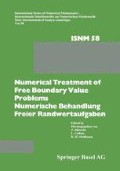Abstract
A problem of gasification and heating of a solid due to the action of an external energy source is discussed. The problem involves a moving boundary when the solid gasifies. At parts of the boundary where gasification is taking place, a model problem looks very much like the one-phase Stefan problem with an energy source at the moving boundary. However, any gas produced is assumed to blow away immediately, and there is no conduction to the solid from the outside, even when the surface temperature of the solid is below the gasification temperature. Accordingly, if the temperature is extended to a function defined over all space by setting it equal to the gasification temperature outside, the temperature will not necessarily be continuous at the boundary, and instead a Neumann condition may be satisfied there. Also, no resolidification is possible, so that the region occupied by the solid cannot increase. Thus, one has the possibility of a situation in which the boundary may alternately move and be stationary.
Access this chapter
Tax calculation will be finalised at checkout
Purchases are for personal use only
Preview
Unable to display preview. Download preview PDF.
References
Berger, A.E., Brezis, H., and Rogers, J.C.W.: A Numerical Method for Solving the Problem ut − Δf(u) = 0. R.A.I.R.O., Analyse Numérique (1979).
Berger, A.E., Ciment, M., and Rogers, J.C.W.: The Alternating Phase Truncation Method for Numerical Solution of a Stefan Problem. SIAM J. Numer. Anal. (1979).
Caffarelli, L.A. and Evans, L.C.: Continuity of the Temperature in the Two Phase Stefan Problem, to appear.
Chorin, A.J., Hughes, T.J.R., McCracken, M.F., and Marsden, J.E.: Product Formulas and Numerical Algorithms. Comm. Pure Appl. Math. 31(1978), 205.
Rogers, J.C.W.: The Formulation of Selected Free Boundary Problems as Conservation Laws, Proceedings of Intensive Seminar on Free Boundary Problems, Pavia (1979).
Rogers, J.C.W. and Favin, S.: Computation of Water Waves. The Johns Hopkins University Applied Physics Laboratory TG1325 (1979).
Sekerka, R.F.: Morphological Stability, Crystal Growth, an Introduction. P. Hartman, North-Holland 1973.
Author information
Authors and Affiliations
Editor information
Editors and Affiliations
Rights and permissions
Copyright information
© 1982 Springer Basel AG
About this chapter
Cite this chapter
Rogers, J.E.W. (1982). Numerical Solution of a Gasification Problem. In: Albrecht, J., Collatz, L., Hoffmann, KH. (eds) Numerical Treatment of Free Boundary Value Problems / Numerische Behandlung freier Randwertaufgaben. International Series of Numerical Mathematics / Internationale Schriftenreihe zur Numerischen Mathematik / Série internationale d’Analyse numérique, vol 58. Birkhäuser, Basel. https://doi.org/10.1007/978-3-0348-6563-0_23
Download citation
DOI: https://doi.org/10.1007/978-3-0348-6563-0_23
Publisher Name: Birkhäuser, Basel
Print ISBN: 978-3-0348-6565-4
Online ISBN: 978-3-0348-6563-0
eBook Packages: Springer Book Archive

